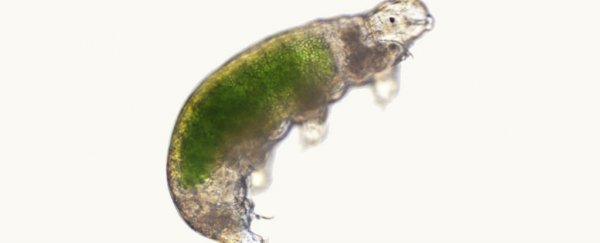A tardigrade that had been frozen solid for more than 30 years has been brought back to life by researchers in Japan, and has gone on to produce 14 healthy babies. That's record-smashing stuff right there, because before this tough little water bear came back to life, the world record for reviving a frozen tardigrade was nine years.
The researchers also thawed out an egg that was collected and frozen with the tardigrade in 1983, and not only did a healthy baby hatch from it six days later, but it went on to successfully produce offspring of its own.
Just a few months after scientists debated the unprecedented amount of foreign DNA that is or isn't looped up into the tardigrade genome, and the discovery that they turn into 'bioglass' when they desiccate, a team from the National Institute of Polar Research in Japan has managed to bring a frozen Antarctic tardigrade (Acutuncus antarcticus) back to life with its reproductive organs fully intact.
At this stage, we shouldn't really be surprised that tardigrades can come back from a serious bout of cryopreservation, since they've already been shown to survive prolonged desiccation and near-100 percent water loss, freezing and boiling temperatures, intense ionising radiation, and the vacuum of outer space. But the fact that tardigrades can continue to produce viable offspring after being frozen for more than three decades is incredible, even by their ridiculous standards.
The tardigrade was collected with another adult and a single egg when researchers were gathering moss from the Showa Station in Antarctica in November 1983. They were stored for 30 years and six months at a temperature of -20 degrees Celsius (-4 degrees Fahrenheit).
Being frozen caused the tardigrades and eggs to undergo a process known as cryptobiosis, in which a complete shut-down of all metabolic processes occurs, including reproduction, development, and repair. Cryptobiosis is used by a number of species in response to hostile environmental conditions such as extreme desiccation, freezing, and oxygen deficiency.
In March 2014, the researchers decided to thaw out their tardigrades and see what happened. Both of their two adult tardigrades - called SB-1 and SB-2 (short for "Sleeping Beauty") - started moving as soon as the defrosting process was complete, but SB-2 soon died because it didn't eat enough.
The researchers have reported their findings in the journal Cryobiology:
"SB-1 first showed slight movement in its fourth pair of legs on the first day after re-hydration. This progressed to twisting of the body from day 5 along with movement in its first and second pairs of legs, but the movements remained slow.
After starting to attempt to lift itself on day 6, SB-1 started to slowly crawl on the agar surface of the culture well on day 9, and started to eat the algal food provided… in the culture plate on day 13."
The SB-1 water bear not only fully recovered from the freezing ordeal after about a week, but also managed to lay a total 19 eggs. Fourteen of these have since hatched, and the babies were all perfectly healthy.
As for the single frozen egg (called SB-3), it demonstrated the incredible potential for a water bear population to reestablish itself after three decades of being frozen. The water bear that hatched from the frozen SB-3 egg ended up laying 15 of its own eggs, seven of which hatched into healthy offspring.
"We recorded recovery of two individuals and development of a separate egg of the Antarctic tardigrade, Acutuncus antarcticus, providing the longest records of survival for tardigrades as animals or eggs," the researchers report.
While SB-1 and SB-3 have certainly achieved an incredible feat, they haven't quite broken the record for the longest time an animal has been frozen before being resurrected. "That distinction belongs to a plant-parasitic nematode worm, Tylenchus polyhypnus, that survived after nearly 39 years in a frozen state," says George Dvorsky at Gizmodo. "Also, second-stage larvae of another nematode, Anguina tritici, were revived after 32 years."
The next challenge for researchers will be to investigate exactly what goes on during the six or seven days after thawing that SB-1 and SB-3 needed to return to normal function. Whatever biological processes they end up discovering, one thing's for sure - they're going to be weird as hell.
